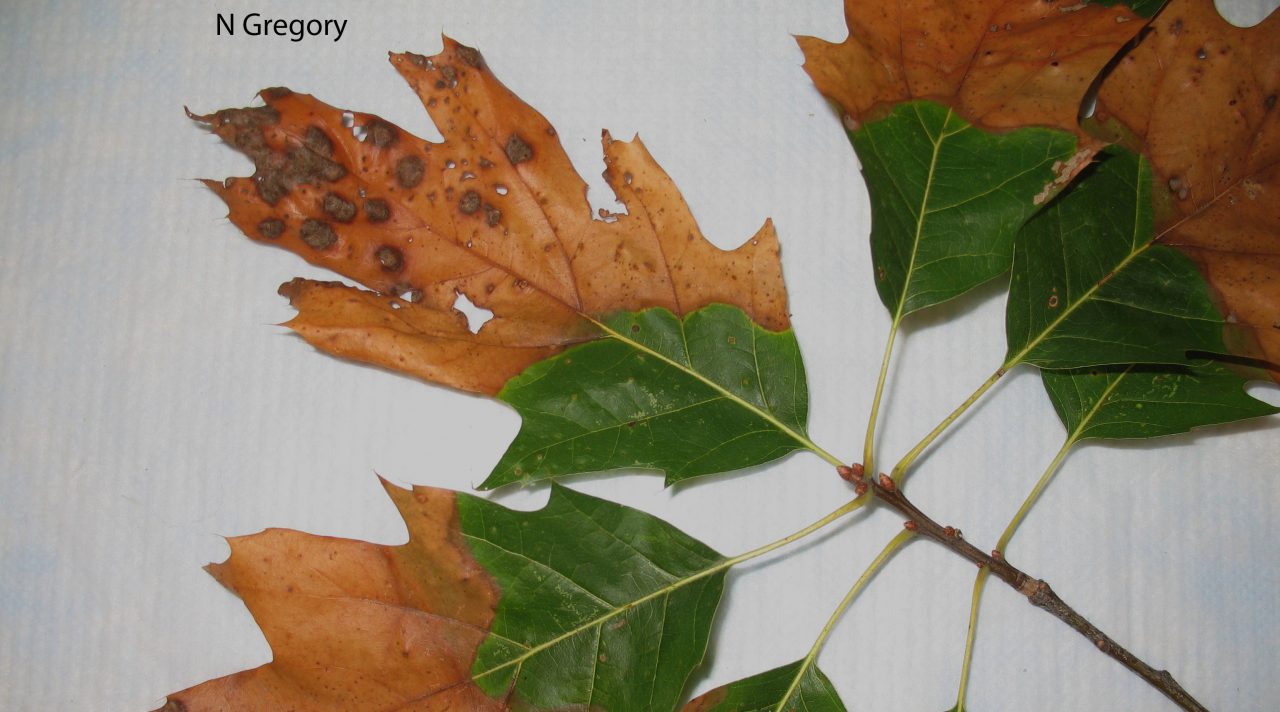
Fact Sheets And Publications

Bacterial leaf scorch
Revised February 2025 by Jill Pollok | Written by: Nancy F. Gregory | Original Publication Date: November 2015
Description and Geographic Distribution
Bacterial leaf scorch (BLS) of hardwood trees, shrubs, and herbaceous plants, is caused by the bacterium, Xylella fastidiosa. The small, xylem limited bacterium is carried from plant to plant by small insects such as leaf hoppers, sharpshooters, and spittlebugs. BLS has been especially damaging to oak trees in the red oak group in Delaware and the Mid-Atlantic states since the early 1990’s. Northern red oak and pin oak have been widely planted in residential neighborhoods and city streetscapes, and trees that are under environmental stress from drought or injuries are more susceptible. Environmental factors can pre-dispose trees to infection and spread of the bacteria within trees. Infection with BLS can pre-dispose trees to other diseases and insect pests.
Bacterial cells are carried in the mouthparts of insects that feed in the xylem, or water-carrying tissue of plants. Bacteria become established and numbers of cells clog the plant tissues, plants produce gumming defense compounds, and symptoms similar to those of drought stress appear. Symptoms include marginal discoloration or scorch of leaves, usually in the late summer or early fall. Marginal discoloration is often accompanied by presence of a yellow band toward the inside of the discolored area. Symptoms are similar to those caused by drought or root issues that interfere with flow of water and nutrients in plants. Plants may not develop symptoms for a year or two after infection, but eventually thinning of branches occurs and trees die within 5 to 7 years.

Host Range and Diagnosis
The host range of Xylella fastidiosa is very large, including many oaks, especially those in the red oak group. Other commonly affected tree species include maple, sycamore, elm, dogwood, and sweetgum. A major problem in residential landscapes is the susceptibility of many shrubs and weed hosts such as blackberry, wild grape, sumac, ivy, Virginia creeper, some clovers, and dandelion. Strains of Xylella cause a problematic disease on grapes, and are also responsible for a disease of olives in Europe.
Due to the similarity of symptoms to other environmental and cultural disorders, a confirmation diagnosis is based on detection of the bacteria in plant tissue. The laboratory test necessary to detect the presence of the causal bacteria relies on sampling approximately 15 petioles of leaves. Attached leaves provide the best specimens, with testing most accurate when leaves are collected in September and October of each year. A positive detection of the bacteria along with dieback indicates that the tree in question will only survive several more years. Severely affected trees should be removed to reduce the inoculum, or the amount of bacteria available to spread to nearby susceptible plant hosts. The bacteria that cause BLS are not harmful to humans or animals.
Management
Due to the very wide host range of Xylella fastidiosa, and the large numbers of hopping insects that may spread the bacteria, prevention of disease is very difficult. Once infected, control or cure is almost impossible. Antibiotics are expensive and not very effective. Management is best accomplished by removing severely affected trees, maintaining good plant vigor, and reducing stress on susceptible hosts. Removing weedy vines may also help slow the spread. Watering during times of drought, mulching, taking care to avoid wounding, and avoiding chemical injury, are all good tree practices. Mixed species of trees in residential plantings helps to avoid monoculture which aids in the spread of disease. Trees in the white oak group and willow oak are not as susceptible as red oaks. Some trees more resistant include black gum, beech, buckeye, linden, and Zelkova.
Collecting Samples
We accept samples from September - November for BLS testing.
The cost for BLS testing is $20/sample, payable by cash or check. Make checks payable to the UD Plant Diagnostic Clinic.
Collect 15-25 symptomatic leaves showing scorch symptoms. It’s best to submit leaves still attached to twigs to prevent them from drying out.
Put the samples in a sealed bag and store them in the refrigerator until submission.
Find the submission form and drop-off locations at www.udel.edu/extension/plantclinic.
Author(s):
Nancy F. Gregory
Revised by Jill Pollok February 2025
Original Publication Date: 11/16/2015
UD Cooperative Extension
This institution is an equal opportunity provider.
In accordance with Federal law and U.S. Department of Agriculture policy, Cooperative Extension is prohibited from discriminating on the basis of race, color, national origin, sex, age, or disability.
